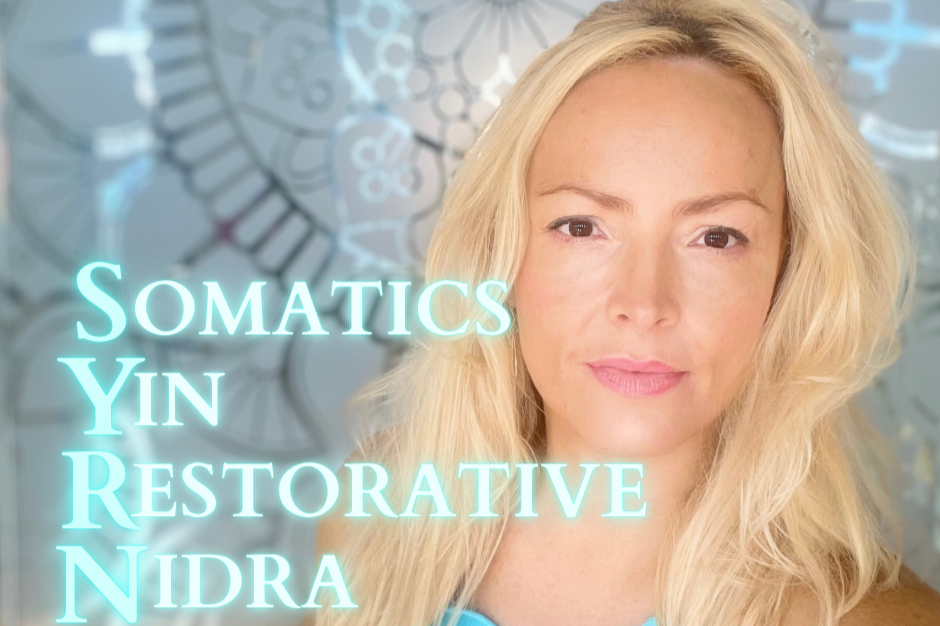The Immersion at my beautiful studio in Sussex
November 14 - 15th we dive in…
From 3 - 9 pm on the Friday evening, then from 11 - 5 on Saturday, you’ll experience extended practices in all four parts of my method, a deep nourishing weekend designed for practitioners to restore and regenerate, and for movement teachers and therapists to learn the art of low-impact working out and restorative yoga
The Science Behind SYRN: A Four-Part Yoga Therapy Method
Over the last 16 years of teaching yoga therapy, I have worked with people of all ages and abilities — from cancer patients and older adults managing blood pressure issues, to athletes, stressed students, and busy parents. Through this experience, I developed SYRN, a structured four-part method that combines somatic movement, Yin yoga, restorative yoga, and yoga nidra.
SYRN is designed to progressively regulate the nervous system, restore balance, and cultivate resilience. Each stage is informed by research in neuroscience, physiology, and psychology.
1. Somatic Movement (10 minutes)
What it is: Gentle, mindful movements that release tension and bring awareness to the body.
Scientific basis:
Proprioception & interoception: Somatic movement activates proprioceptive pathways (awareness of where the body is in space) and enhances interoception (awareness of internal states). Improved interoception has been shown to support emotional regulation and stress resilience.
Fascial mobilisation: Dynamic, fluid movement gently stimulates fascia and synovial fluid, improving joint health and preparing tissues for stillness.
Nervous system priming: Engaging in conscious movement lowers sympathetic (fight-or-flight) activity, creating the conditions for deeper parasympathetic rest.
2. Yin Yoga Pose for Meditation & Stillness
What it is: A long-held, floor-based posture designed to gently stress connective tissue while encouraging meditation and inward focus.
Scientific basis:
Fascia & joint health: Prolonged holds affect connective tissue, increasing hydration, elasticity, and mobility.
Nervous system down-regulation: Sustained stillness increases parasympathetic tone, helping reduce heart rate and blood pressure.
Brain networks: Yin encourages engagement of the brain’s default mode network (DMN), which supports introspection, creativity, and meditative states.
3. Restorative Yoga Posture
What it is: A fully supported position using props to create complete ease in the body.
Scientific basis:
Parasympathetic dominance: Restorative yoga activates the vagus nerve, increasing heart rate variability (HRV) — a marker of resilience and adaptability.
Stress hormone reduction: Research shows restorative postures help reduce cortisol and adrenaline, essential for recovery and healing.
Blood pressure regulation: Supported positions enhance baroreflex sensitivity, a key mechanism in balancing blood pressure, particularly important for those with cardiovascular concerns.
4. Yoga Nidra (20 minutes)
What it is: A guided deep relaxation practice often referred to as “yogic sleep.”
Scientific basis:
Brain states: Yoga nidra induces a hypnagogic state between waking and sleeping, where the brain shifts into theta and delta wave patterns associated with deep rest and repair.
Neurochemistry: Research indicates it boosts levels of GABA, a calming neurotransmitter that helps reduce anxiety and promote relaxation.
Clinical benefits: Studies have found yoga nidra to be effective in reducing symptoms of insomnia, PTSD, chronic pain, and stress-related conditions.
Restorative power: A 20-minute yoga nidra can provide rest equivalent to several hours of sleep, supporting memory, learning, and emotional balance.
Why SYRN Works as a Whole System
Progressive nervous system regulation: Each stage guides the practitioner from gentle activation (somatic movement) into progressively deeper states of parasympathetic rest (yin, restorative, nidra).
Holistic healing: By addressing the body, breath, and mind in sequence, SYRN works across physical, emotional, and cognitive layers of wellbeing.
Accessible to all bodies: SYRN can be adapted for people of all ages and conditions, making it a safe and inclusive practice.
Conclusion
The SYRN method blends traditional yoga wisdom with modern science. It is a practice of progressive release: moving from embodied awareness to stillness to deep rest. In a world where stress, fatigue, and disconnection are widespread, SYRN offers a practical, evidence-informed path back to balance.
In all my years as a yoga instructor and yoga therapist, this is the most effective way I have found to invite and maintain all the healing and restorative benefits of the slower offerings from yoga practice. Simply, it works.
SYRN: The Immersion — November 2025
Created and led by Bryony — Yoga Therapist (Minded Institute, since 2014)
A science-informed pathway from movement to deep rest. Join the November immersion and experience Bryony’s signature therapeutic method that soothes the nervous system and restores balance.
What is SYRN?
SYRN is a gentle yet profound four-stage process — Somatics, Yin, Restorative & Yoga Nidra — refined by Bryony at Be Yoga since 2014. It blends yoga therapy with neuroscience to soothe the nervous system and retrain the body–mind to rest.
The Four Stages
Mindful micro-movements re-educate brain–muscle pathways and improve interoception.
Long, supported shapes nourish fascia and enhance vagal tone and emotional regulation.
Full support invites the baroreflex response, easing heart rate and blood pressure.
Guided Yoga Nidra tends toward theta/delta brain states linked with deep restoration.
“Rest is not a reward for work — it is the work.”


